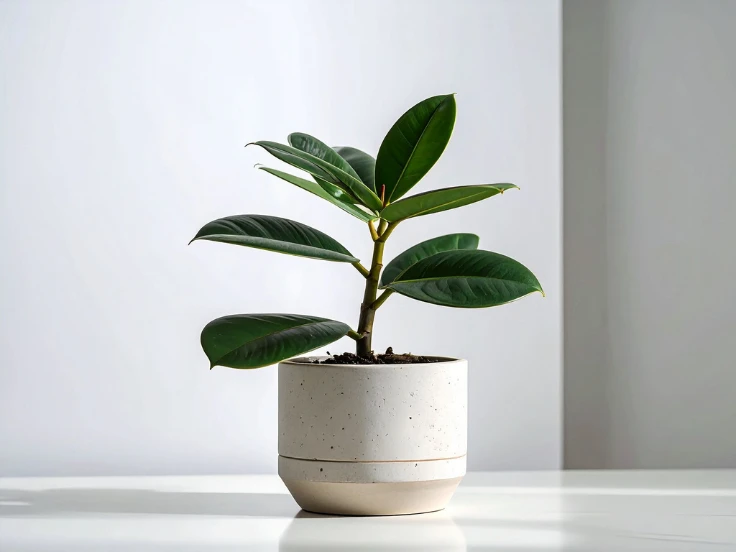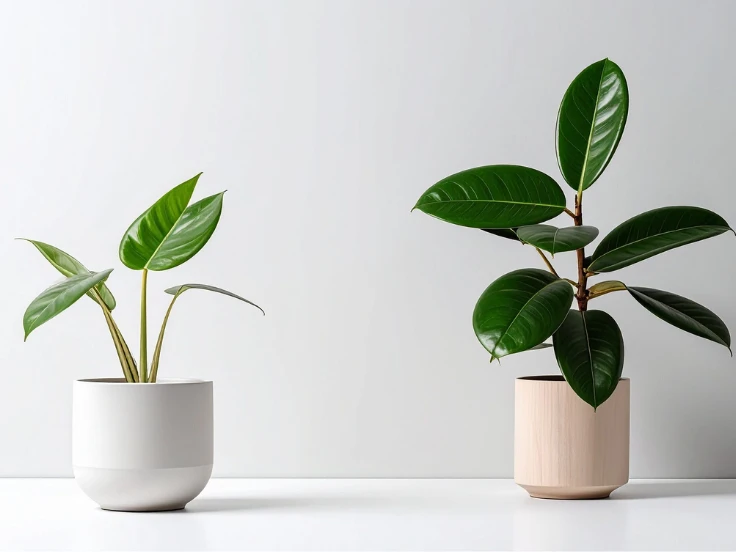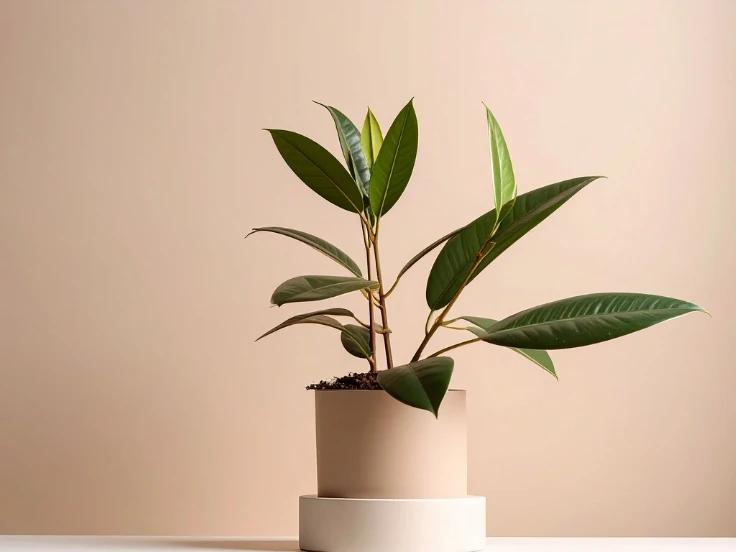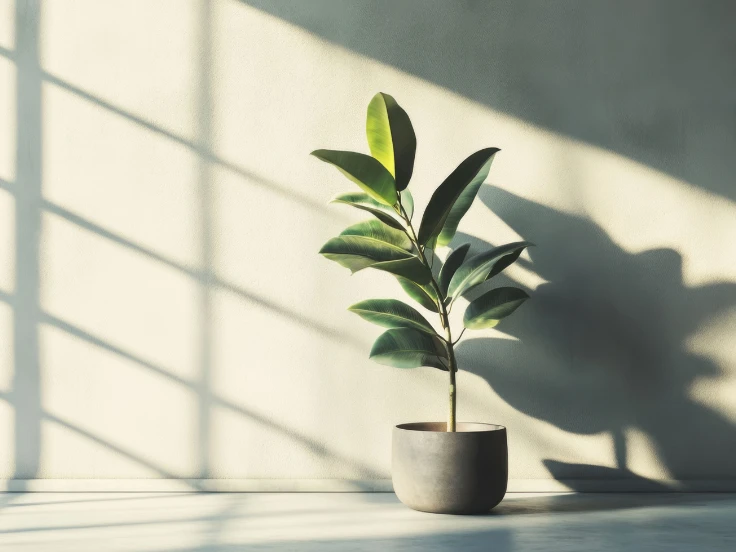The rubber plant (Ficus elastica) has become a favorite among indoor gardeners because it offers both beauty and functionality. Many homeowners appreciate it not only for its lush appearance but also for the numerous rubber plant indoor benefits it brings into a living space.
These benefits range from improved air quality to enhanced emotional well-being. As indoor environments become more central to everyday life, people increasingly lean toward easy-care plants that elevate comfort, design, and health. The rubber plant fits these needs effortlessly while requiring minimal maintenance.
This resilient plant adapts to apartments, offices, and homes alike. With its elegant leaves and natural air-purifying ability, it creates a calm, wellness-focused indoor space. Regular care ensures it stays vibrant and continues enhancing your home’s atmosphere.
How Rubber Plants Improve Indoor Air Quality

Indoor air quality has become increasingly important due to the rise of synthetic materials, household chemicals, and sealed environments. One of the most valuable rubber plant indoor benefits is its ability to filter harmful toxins, including formaldehyde, volatile organic compounds, and carbon pollutants.
Moreover, the plant’s large surface area allows it to absorb contaminants efficiently and release fresher, cleaner oxygen back into the room.Furthermore, the rubber plant helps regulate indoor humidity through a natural process called transpiration.
This contributes to easier breathing, reduced dryness, and improved comfort—especially in rooms affected by heaters or air conditioning. Because of these combined qualities, the rubber plant stands out as a powerful natural purifier that enhances overall home livability.
Key Wellness Benefits of the Rubber Plant Indoors
Rubber plants offer meaningful wellness advantages that contribute to healthier and more balanced indoor living. Before exploring the science behind these effects, here is a quick overview of their impact.
-
Improved oxygen levels
-
Reduction of airborne toxins
-
Stabilized indoor humidity
-
Lowered stress levels
-
Allergy-friendly foliage
Design Advantages of Rubber Plants: Indoor Aesthetic Benefits
The rubber plant has become a favored décor element due to its timeless appearance and versatility. It works beautifully in both modern and traditional interiors while adding bold visual structure to a room.
-
Large, glossy leaves that create natural focal points
-
Available in striking varieties like burgundy and variegated
-
Ideal for filling empty corners or bright entryways
-
Functions as a natural room divider
-
Suitable for offices, studios, and large living areas
Stress-Reducing Benefits of Indoor Rubber Plants

Houseplants have long been linked to emotional relaxation, and the rubber plant is especially effective in promoting a calm indoor atmosphere. Its thick foliage and upright growth habit create a visually grounding effect that helps reduce mental fatigue. Additionally, the plant introduces a sense of stability and warmth into the home.
Because modern lifestyles involve significant screen time, having structured greenery in frequently used rooms provides a valuable natural counterbalance. By simply existing in your living space, the rubber plant improves mood, encourages relaxation, and enriches emotional well-being.
Rubber Plants for Productivity and Focus
The rubber plant also enhances mental clarity, making it an excellent addition to home offices or study spaces. Cleaner air naturally improves focus, while the plant’s uniform leaf pattern reduces visual stress. Moreover, its presence contributes to a more organized and balanced work environment.
Studies consistently show that incorporating greenery into workspaces increases productivity, boosts creativity, and enhances task performance. A rubber plant achieves these benefits without requiring intensive care, making it ideal for busy individuals seeking both beauty and practicality.
Indoor Rubber Plant Care Tips to Maximize Benefits

To fully enjoy rubber plant indoor benefits, proper care is essential. These plants thrive in medium to bright indirect light but can still tolerate slightly lower light conditions. They prefer slightly moist soil, although they react negatively to overwatering. Maintaining consistent humidity helps support vibrant, healthy foliage.
With the right environment, your rubber plant will grow steadily, becoming an elegant indoor tree capable of transforming any room. Regular rotation ensures balanced growth, while occasional leaf cleaning helps maintain the plant’s natural shine.
Quick Care Tips for Maximizing Rubber Plant Indoor Benefits
-
Water when the top inch of soil becomes dry
-
Keep the plant near bright indirect light
-
Avoid sudden temperature changes
-
Maintain moderate indoor humidity
-
Wipe leaves regularly to prevent dust buildup
Common Rubber Plant Care Mistakes
Even though rubber plants are hardy, certain mistakes can limit their growth and reduce their effectiveness indoors. Overwatering is the most common issue, leading to root rot and dull leaves. Additionally, placing the plant in deep shade causes slow growth and thin, leggy stems.
Ignoring humidity needs may also cause leaf curling or browning at the edges. By being mindful of these common care errors, you ensure that the plant maintains its full beauty and function. Proper humidity helps your rubber plant thrive, keeping leaves glossy and vibrant.
Care Errors That Limit Rubber Plant Indoor Benefits
-
Overwatering or poor drainage
-
Keeping the plant in very low light
-
Using compact soil that prevents aeration
-
Failing to maintain humidity
-
Allowing dust to accumulate on leaves
Do Rubber Plants Improve Air Quality?
Yes rubber plants genuinely improve indoor air quality, particularly when used as part of a larger indoor plant collection. They actively absorb toxins and convert stale air into oxygen-rich air. Additionally, their consistent transpiration helps balance humidity, improving the indoor environment significantly.
While one plant cannot purify an entire home, placing rubber plants in multiple rooms offers noticeable advantages. When combined with other air-purifying plants, the results become even more impressive. Even a few strategically placed rubber plants can significantly refresh your indoor air.
Are Rubber Plants Safe for Homes With Pets or Children?
Rubber plants are mildly toxic when ingested, especially to cats and dogs. Although they typically do not cause severe reactions, ingestion can result in gastrointestinal discomfort. Therefore, it is wise to keep them on elevated surfaces or stands if your pets tend to chew on plants.
Additionally, the milky sap from the stems may irritate sensitive skin, making it important to wash hands after pruning or repotting. Despite these considerations, rubber plants remain safe and manageable with simple preventive measures.
FAQs
Do rubber plants grow quickly indoors?
They grow at a steady pace, especially when provided with bright indirect light.
Do rubber plants need much water?
No. Water only when the top layer of soil begins to dry.
Can rubber plants survive low light?
They can survive low light, but they thrive in brighter indirect light.
Conclusion
The rubber plant continues to be one of the most valuable indoor plants due to its numerous health, design, and wellness benefits. It enhances indoor air quality, reduces stress, supports productivity, and adds timeless beauty to any room. With minimal care requirements and strong adaptability, it suits both beginners and experienced plant owners.
For plant enthusiasts looking to expand their indoor garden, learning proper care techniques for other popular houseplants, such as the indoor hydrangea, can complement the benefits of a rubber plant and create a more vibrant, healthy home environment.
The many rubber plant indoor benefits make it a smart choice for improving living spaces and supporting emotional well-being. It adds style, cleans the air, and creates a calming indoor retreat. For low-light areas, explore indoor house plants that thrive with no light to keep your home green and vibrant.


















